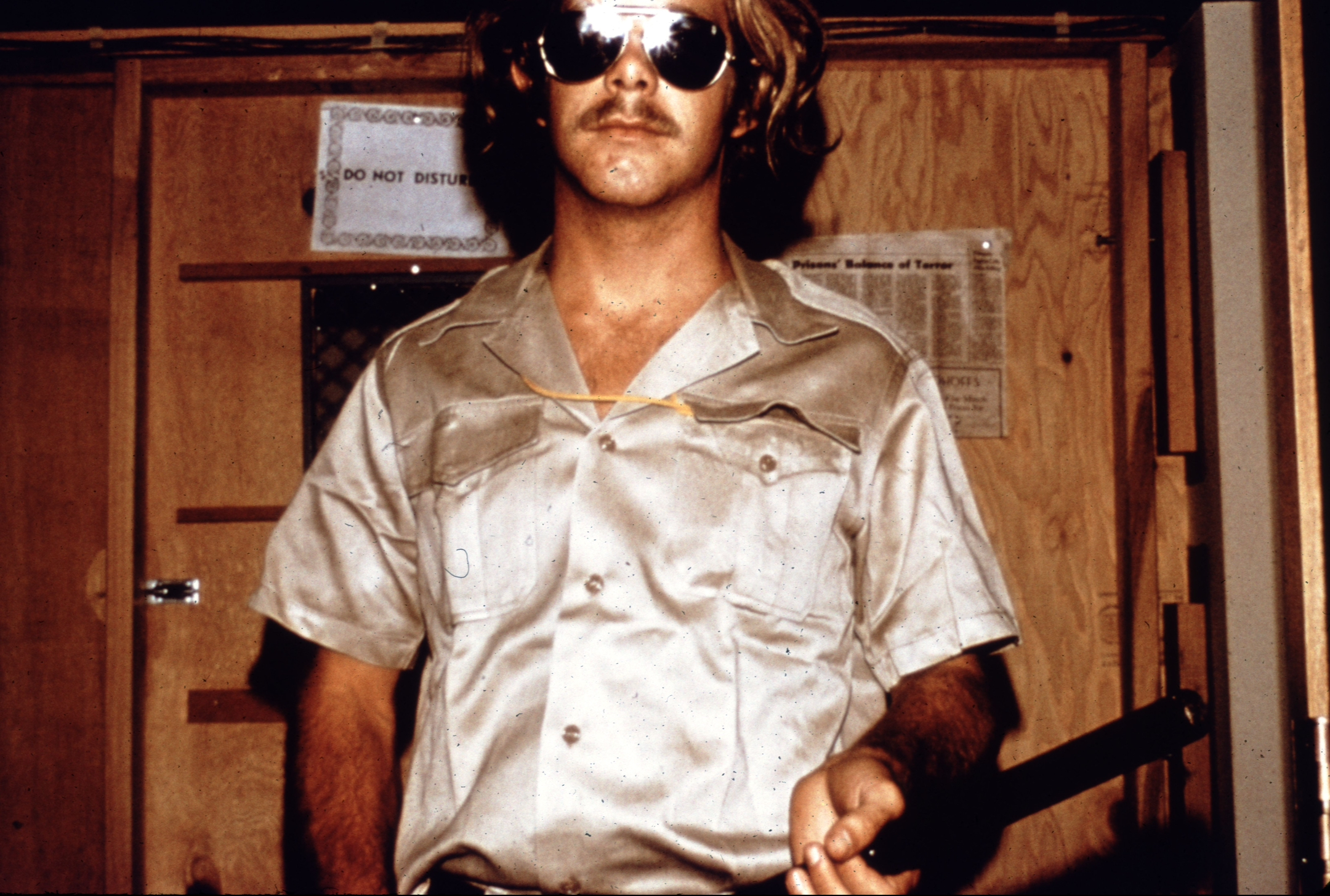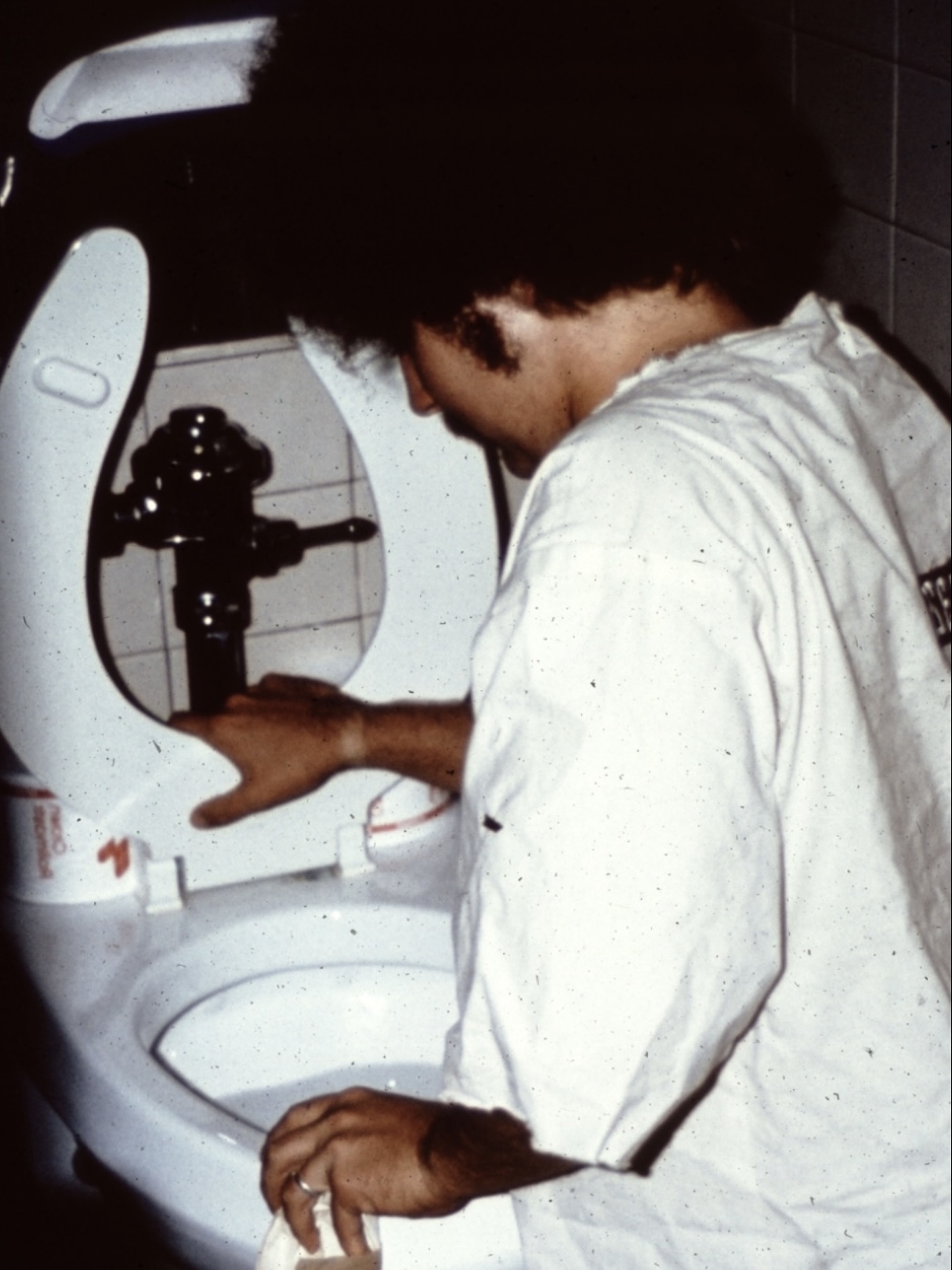Phillip Zimbardo, Guard Taking Beds Away, 1971.

Phillip Zimbardo, Prison Guard John Wayne, 1972.
Zimbardo ended his experiment early, because it violated the prisoners’ human rights by subjecting them to harm.
The prisoners in the Stanford Prison Experiment were mentally harmed as a way to make them lose all sense of individuality.
Due to the mental abuse he was experiencing from the guards, "Prisoner #8612 was suffering from acute emotional disturbance, disorganized thinking, uncontrollable crying, screaming and rage."
Phillip Zimbardo, The Stanford Prison Experiment, Pg. 8.
After being mentally abused, Prisoner 819 was "crying hysterically, while in the background his fellow prisoners were chanting and yelling that he was a bad prisoner and that they were being punished because of him…He told me that he couldn’t leave knowing that the other prisoners thought he was a bad prisoner…I managed to get through to him by reminding him who he really was and what this place really was and who I really was. As that other reality broke though, he agreed to be released from his imprisonment and quit the experiment."
Phillip Zimbardo, Quiet Rage.
"I don't think most people realize that lots of the tension created in the experiment came from sleep deprivation and waking prisoners in the middle of the night for prisoner counts. This is a form of internationally recognized torture. The American psychological society has since banned this type of experiment using these techniques, but Zimbardo and his staff allowed and encouraged this behavior and other behavior to prisoners."
John Mark, IwasA Guard in the 1971 Stanford Prison Experiment. AMA!
The prisoners were isolated from their families, a mental tactic used by the guards. Their families "were taught in short order that they were our guests, allowed the privilege of visiting only by complying with the regulations of the institution. They had to register, were made to wait half an hour, were told that only two visitors could see any one prisoner; the total visiting time was cut from an hour to only 10 minutes, they had to be under the surveillance of a guard."
Philip Zimbardo, Curtis Banks, Craig Haney and David Jaffe, The mind is a formidable jailer, Pg. 10.

Phillip Zimbardo, Prisoner 819 Crying, 1972.
Phillip Zimbardo, Prisoners Chanting 819 Did a Bad Thing, 1971.
The guards became increasingly more brutal and creative in their methods of controlling the prisoners through isolation, which caused them harm overtime.
Phillip Zimbardo, Guard Taking Beds Away, 1971.

Phillip Zimbardo, Prison Guard John Wayne, 1972.
"One of the guards came up with the idea of using psychological tactics instead of physical ones. The guards set up a privilege cell and the prisoners who were least involved in the rebellion were put in there and given special privileges. They got their uniforms back, they were allowed to wash themselves and brush their teeth. The others were not. Beds were returned to the privilege cell. Prisoners in the privilege cell were offered a special meal, while the others were only allowed to watch."
Phillip Zimbardo, Quiet Rage.
In one case, prisoner 416 "was ordered into the hole and ordered to hold the sausages in his hands. The guards threatened to cancel Thursdays visiting hours for all prisoners, if 416 did not eat his sausages. 416 refused again. The guards then channeled the frustration of the other prisoners by having them express their anger at 416, who was in the hole."
Phillip Zimbardo, Quiet Rage.
Prisoner 416 recalls that when he refused to eat his sausages, "They did try to jam food down my throat."
Clay Ramsey, The Hallway.
When asked about throwing prisoner 416 in the hole, former guards recall that, "both Dave and I were just enraged that this guy was challenging our authority. And so we put him in the hole. In order to turn the prisoners against the prisoner who went on a hunger strike, we let them know that if he was not gonna eat his dinner, we would take their blanket away."
Burton and Eschelman, The Hallway.
One former prisoners remembers how the guards scared 416 when he was alone as, “Later that night he’s still in the closet. The guard ordered the prisoners to pound on the door."
Shue, The Hallway.
The prisoners were made to do difficult tasks and were physically tortured as punishment for non compliance.
One of the guards yelled at a prisoner who wasn't cooperating and said, 'hey, did I say that you could laugh, 819? Maybe you didn't hear me right.' Hellmann is getting angry for the first time. He gets right up in the prisoner's face, leans on him, and pushes him back with his billy club."
Phillip Zimbardo, The Lucifer Effect, Pg. 49.
"Push-ups were a common form of physical punishment imposed by the guards to punish infractions of the rules or displays of improper attitudes toward the guards or toward the institution…one of our guards also stepped on the prisoners’ backs while they did enforced push-ups toward the end of the experiment."
Phillip Zimbardo, The Stanford Prison Experiment, Pg. 5.
In the experiment, Zimbardo mentions how there were "prisoners, who are going to be dehumanized, they’ll become numbers. Here are the guards with symbols of power and anonymity. Guards get prisoners to clean the toilet bowls out with their bare hands, and do other humiliating tasks."
Phillip Zimbardo, The Psychology of Evil.

Phillip Zimbardo, Prisoner Cleaning Toilet, 1972.
Phillip Zimbardo, Quiet Rage: The Stanford Prison Experiment, 1988.
Zimbardo's failure to end the experiment after it became clear that prisoners were being harmed resulted in numerous ethical violations.